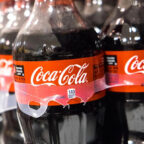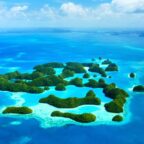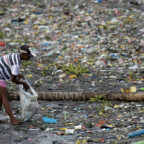
The 5 Gyres Institute’s pilot program takes high school students on ocean expeditions to show them how to collect and analyze plastic trash – with the goal of inspiring careers as scientists, policymakers and advocates.
On a bright, clear morning last week, the water was calm and flat at the Newport Beach marina in Southern California. It was the perfect day for seeing marine life in the Pacific Ocean – and for collecting plastic, according to Marcus Eriksen, cofounder and research director of the 5 Gyres Institute, a Los Angeles-based ocean conservation nonprofit.
As Eriksen stood on the top deck of the Newport Legacy, a whale watching boat, 50 students and a few teachers from Animo Venice Charter High School climbed on board the lower deck. The 10th graders were there as part of a 5 Gyres’ pilot program, Mi Mar/My Sea, which brings underserved students from high schools in urban neighborhoods to the coast to participate in one-day ocean research expeditions collecting and analyzing marine plastic pollution. The hope is that students leave the excursion more informed about their local ecosystems and how they can be part of the solution to plastic pollution and other threats to the ocean.
Eriksen’s organization undertakes ocean expeditions to collect samples of tiny bits of broken-up plastic, called microplastic. With an estimated 8.3 million tons of plastic trash entering the ocean each year, 5 Gyres hopes to pinpoint plastic pollution hotspots and determine what kinds of plastic are most prevalent there. According to Eriksen, it’s critical for young people to be involved in these efforts so they can push for future research and policies that curb plastic production, use and pollution.
“When we teach young people about environmental problems and science, it opens eyes and inspires care for the world we live in,” he said. “It can also spark young people’s passion for science, expanding students’ educational and career horizons.”
The boat motored about 3 miles (5km) out of Newport Harbor and into the Pacific, following a pod of playful common dolphins. While the boat’s crew focused on finding and teaching the students about local marine life, which that day included many dolphins and seabirds, Eriksen and his crew briefed them about 5 Gyres’ work. He passed around pieces of plastic with tooth imprints of fish, and also allowed students to hold a huge calcified mass of plastic rope and bags he found in a camel’s stomach in Dubai. “I wanted to show the students that plastic pollution is not just an ocean issue, that it all starts on land and affects land animals,” Eriksen said.
After the briefing, it was time to get to work: Eriksen, a sturdy former Marine, placed a heavy and nearly 5ft (1.5m)-long rectangular metal device called a manta trawl in the arms of a half-dozen students. They helped him haul the trawl to the back of the boat and throw it into the water on the count of “1, 2, 3, splash!” The trawl – shaped roughly like the animal after which it’s named, with an open “mouth” and “wings” – catches tiny plastic bits floating on the surface of the water in a mesh tube that trails behind it. The captain steered the boat along the coast at a slow pace so the manta trawl – which was designed to be pulled at no more than a few knots – would fill with plastic.
“Taking samples of microplastic tells us about the amount and composition of plastic litter in the marine environment,” said Stephanie Whyte, programs manager at 5 Gyres who was also on the boat that day. “On these trips, students see that their local marine environment is polluted and we hope that inspires them to action, to make changes in their everyday lives to use less plastic and also to teach them that science is important in keeping both the environment and people healthy.”
Thirty-two minutes after throwing the trawl in the ocean, Eriksen directed the students to help him bring it up from the water and into the ship. After they managed to haul the trawl up to the top deck, the students helped Eriksen empty its contents into a small sieve. “You can see there’s a lot of sea plants, but also a decent amount of plastic,” Eriksen said, pointing at the small particles in the bottom of the sieve.
Christian Marroquin, a 15-year-old high-school student at Animo Venice, volunteered to record the sample data. He noted time and ship position at both the deployment and pickup of the trawl as well as the sea and boat conditions in a binder provided by 5 Gyres. As students analyzed the plastic, he tallied off the various types of plastic found, from small plastic fibers and microbeads to larger chunks. The data can give a clearer picture about the quantity and quality of plastic in a given area of ocean.
“There is more plastic than I expected, and that’s a wake-up call,” Marroquin said. “This is a rare opportunity to do important science that will hopefully bring positive change to the world.”
Animo biology teacher Adriana Jaureguy said that many of her students show an intense interest in science but her school does not have the means to give all of them access to in-depth science resources. “I was thrilled when our school was asked to participate in this program,” she said. “We pitched the idea to the entire 10th grade and the first 50 students who signed up during their lunch period were accepted. There was a huge demand and not enough space. I wish we could have brought them all.”
Mi Mar/My Sea is currently in the pilot stage, and the sail with the students from Animo Venice was the second that 5 Gyres have coordinated. Two more trips with students from other underserved high schools are planned for the fall. If 5 Gyres can continue to secure funding, the plan is to expand the program and mount annual expeditions.
“Without programs like this, these students may never consider a job in the sciences,” said Jaureguy. “What may look like just a class field trip may affect the trajectory of the rest of their lives and ultimately the world.”















Social Profiles